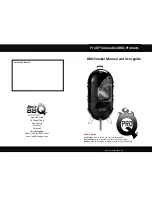
ASSEMBLY
Failure to follow these instructions may result in injury and
equipment damage/malfunction.
1. Smoke alarm/s must be installed by a licensed electrician.
2. All interconnected smoke alarms must be supplied from the
same circuit.
3 A common neutral must be used for the interconnect to operate.
4. DO NOT connect the interconnect wire to active or neutral. Ensure
neutral is connected to the terminal for hardwired interconnection.
5.
A maximum of 40 smoke alarms can be installed on one
circuit (wired interconnection only).
6. Alarm will not attach to mounting bracket unless battery is installed
correctly.
Warning:
This smoke alarm is not suitable for wall (vertical)
mounting.
LOCATION OF SMOKE ALARMS
For maximum protection smoke alarms should be installed in
every room (except areas described in the previous section
‘Locations to Avoid’) to ensure people in the home will be able to hear
and respond to the alarm. At the very least install one smoke alarm on
every floor.
If you suspect a household member may not hear this smoke alarm
i.e. outdoor or indoor noise, sound sleepers, drug or alcohol usage,
the hard of hearing, etc install and maintain a specialty smoke alarm
device.
NOTE: In Australia each state has a different legislation when it comes
to smoke alarms. Please visit the relevant authority in your state for
specific legislation requirements.
LOCATIONS TO AVOID
1.
Don’t place alarms in bathrooms, kitchens, garages or
other rooms where the alarm may be triggered by steam,
condensation and normal smoke/heat from appliances.
2.
In areas with high humidity, like bathrooms or areas near
dishwashers or washing machines, install at least 3m away from
these areas.
3. Near air returns or heating and cooling supply vents, install
at least 1m away from these areas. The air could blow smoke away
from the detector, interrupting its alarm.
4. In rooms where the temperature may fall below 0°C or rise above
40°C (due to nuisance/false alarm activation).
5.
In extremely dusty, dirty, or insect infested areas where
particles may interfere/obstruct with Alarm operation.
6. Away from air conditioning or ventilation grilles/louvers.
TYPICAL MULTI-STORY OR SPLIT LEVEL HOME
For maximum protection, a smoke alarm should be installed on the
ceiling of each bedroom, living area, and hallway. Where a hallway
is more than 10 meters long install a smoke alarm at each end. Also
install a smoke alarm above each staircase.
For minimum protection, a smoke alarm should be installed above
each staircase, including the basement.
POSITION OF SMOKE ALARMS
Smoke will spread horizontally after rising to the ceiling, so it’s
advisable to install the smoke alarm in the centre of the ceiling where
possible. Avoid areas where there is no circulation.
•
When mounting an alarm on the ceiling, locate it a minimum of
30cm from the side wall.
•
Install smoke alarm/s on slopped, peaked or cathedral ceilings
between 50cm and 250cm from the highest point of the ceiling.
TYPICAL SINGLE-STORY HOME
For maximum protection, a smoke alarm should be installed on the
ceiling of each bedroom, living area, and hallway. Where a hallway is
more than 10 meters long install a smoke alarm at each end. If there
is a basement install a smoke alarm on the basement ceiling at the
bottom of the stairwell.
Additionally, a smoke alarm should be installed in the hallway
between the living areas (incl. kitchen) and bedrooms. Place it as near
to the living areas as possible and ensure the smoke alarm is audible
when bedrooms are occupied.
LIVING ROOM
BATH
KITCHEN
BEDROOM
BEDROOM
BEDROOM
BEDROOM
FAMILY ROOM
BEDROOM
BEDROOM
KITCHEN
DINING
ROOM
LIVING
ROOM
BATH
Smoke alarm
for minimum protection
o
Smoke alarm
for additional protection
Smoke alarm
for minimum protection
o
Smoke alarm
for additional protection
Screw
Smoke Alarm
Ceiling
Install Bracket
Install hole






















